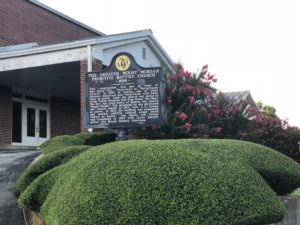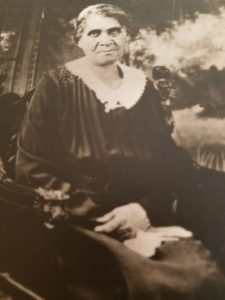Our Approach
 The History of the Mt. Moriah P.B. Church
The History of the Mt. Moriah P.B. Church
During the late 1800s, black people of the West Florence community, where there were only a few houses known as Handy Hill (named after the W. C. Handy family who lived at the top of the incline) were God fearing and God seeking people who had no place to worship except in different homes. Although facing many obstacles, they kept God in front of them and carried on from house to house, praying as they went and giving thanks to the Lord for what they had.
The double-framed, two-room houses used for worship were located in the Fair Ground area, so named because it was the former site of the fairgrounds and was also used for an old race track for horses. Finally, worship was held at the home of Mrs. Betsy Key until the group purchased a small plot of ground next to Mrs. Betsy Key’s home on Fish Trap Road in the Fair Grounds area. After this lot was purchased, a small A-frame building was erected and Rev. Fenny served as Pastor for a while, after which Rev. Andy Sloss served as Pastor. Revivals were held in this little frame building with many being converted. This church was known as Fair Grounds Church.
 In the late 1890s, at the age of sixteen, Sis. Mary Ola Key professed religion and was about to be baptized in the Tennessee River when the spirit spoke to her instructing her to join Mt. Moriah Church. After the baptism, they were faced with a dilemma because there was no Mt. Moriah. When the word spread of Mary Ola Key’s spiritual instruction, it was taken to mean that a church should be organized. When time came to organize the church, members were borrowed from Rock P. B. Church to help in the organization. Those members were Brothers Ruffin Key, Matt Key, Alex Weakly, Nelson Thompson, Robert McDaniel, Finney Thomas, Pat Braham and Sister Nerva Thompson along with Sis. Betsy Key. They then sent for the Moderator, Rev. Marion Williams for the purpose of organizing this church.
In the late 1890s, at the age of sixteen, Sis. Mary Ola Key professed religion and was about to be baptized in the Tennessee River when the spirit spoke to her instructing her to join Mt. Moriah Church. After the baptism, they were faced with a dilemma because there was no Mt. Moriah. When the word spread of Mary Ola Key’s spiritual instruction, it was taken to mean that a church should be organized. When time came to organize the church, members were borrowed from Rock P. B. Church to help in the organization. Those members were Brothers Ruffin Key, Matt Key, Alex Weakly, Nelson Thompson, Robert McDaniel, Finney Thomas, Pat Braham and Sister Nerva Thompson along with Sis. Betsy Key. They then sent for the Moderator, Rev. Marion Williams for the purpose of organizing this church.
After the church was organized the Moderator asked: “What shall be the name of this church?” The majority said they would name it whatever the recently baptized candidate, Mary Ola Key said. The candidate was asked to rise and speak. She rose and said, “Brother Moderator, the Lord told me to join Mt. Moriah.” The Moderator asked, “Are you sure of this, Sister Key?” She replied, “The Lord told me twice in the Spirit to join Mt. Moriah.” The Moderator said “Mt. Moriah shall be the name of this church.”
After the organization and naming of the church, three deacons: Will Johnson, Ruffin Key and Rob McDaniel, whose membership was formerly at Rock P.B. Church, were ordained as the first deacons of Mt. Moriah and later, Brother John Rolf was added as deacon. Some of the first mothers of the church were Sis. Nerva Thompson, from Rock P.B. Church, Sis. Mary Ola Key and Affie Rolf. Rev. Andy Sloss served as Pastor until he left to go into another religious field. Rev. Bill Owens was then elected to serve as Pastor and he served until his death. In the early 1920s, Rev. C. A. Crump was elected as Pastor. Under Rev. Crump’s leadership, they purchased a lot on the north side of Fish Trap Road, now known as Irvine Avenue, and built a large wood-framed building on the lot west of and next to the present building- moving from the Fair Ground Church. During this time, the following ministers were ordained: George Gibson, Ed Brown and Polk Germany from St. Paul Church and Deacons Charlie Johnson, Arthur Hardin, Dan Houston, Martin Reeder, Robert Haley, William Key, Josh Nelson from Nazareth, Charlie Garrett from Cedar Grove, M. Smith from Rock P. B. Church and T. M. Coffee from Mt. Zion. Some of the other earlier Deacons were Felix Boddie, Joe Brown and Andrew McDaniel. Some of the early Mothers were Nettie Kendrick, Marie Brown, and Pricilla Key to name a few.
As time passed, many members joined and the Church decided that they needed a larger place of worship. They then purchased a lot alongside this frame building from longtime Florence businessman, Mr. Frank M. Perry, and began making plans to start construction on this present House of Worship. The Church and the community pulled together to raise money for the new building. They held “chitlin’ struts” that they usually started preparing for the night before. A “chitlin’ strut” simply meant that chitterling dinners, including sweet potatoes, turnip greens and corn bread were sold from homes where music was played and people would gather to eat the soul- food staple and socialize. Sometimes fried catfish plates were sold along with homemade ice cream. The suppers and chitlin’ struts are as valuable a part of history for the community and for Mt. Moriah Primitive Baptist Church as for the materials for which to build the structure. Sisters working hand in hand and brothers working side by side, all trusting in the Lord and praying as they worked and started the task of building.
and the Church decided that they needed a larger place of worship. They then purchased a lot alongside this frame building from longtime Florence businessman, Mr. Frank M. Perry, and began making plans to start construction on this present House of Worship. The Church and the community pulled together to raise money for the new building. They held “chitlin’ struts” that they usually started preparing for the night before. A “chitlin’ strut” simply meant that chitterling dinners, including sweet potatoes, turnip greens and corn bread were sold from homes where music was played and people would gather to eat the soul- food staple and socialize. Sometimes fried catfish plates were sold along with homemade ice cream. The suppers and chitlin’ struts are as valuable a part of history for the community and for Mt. Moriah Primitive Baptist Church as for the materials for which to build the structure. Sisters working hand in hand and brothers working side by side, all trusting in the Lord and praying as they worked and started the task of building.
During those days, if anyone wanted anything moved, you called Willie Boyd, who had a mule and wagon, or dray as it was then called. Boyd’s dray hauled sand and gravel from the banks of Cypress Creek. Community volunteers, such as Louise Mitchell, Rosabell Kinnard, Mary Ola Key and others used the supplies to make what was called “Catface Blocks” that are similar to blocks used in today’s household basements. Catface Blocks, however, usually weighed 75 pounds each and were sturdier and longer lasting. Workmen also used the sand to make cement to hold the blocks together. It is not known today how they were able to make the sand hold the blocks, it was just something they knew how to do back then. Some of those original blocks are stored in the current church’s basement. In addition to making blocks, many financial donations were given and costly materials donated. Almost everyone in the community would help work on the church, even the children. When the young boys came home from school, they would even come out and work. Finally, the last nail was driven, the last block was laid and the building was completed.
The members then moved from the frame building to the new block building. It was dedicated to God and what a glorious time was had on that day. The church membership increased greatly during this time. Rev. Crump pastored until his health failed, during which time Rev. Gibson, the Associate Pastor, served as Interim Pastor until the church decided it was time to elect another pastor. Sis. Madge Rigley taught kindergarten during the early years of the church.
In 1952, the church elected Rev. David Tolbert, Sr., from Hillsboro, Alabama as pastor. During the 30-year administration of Rev. Tolbert, many positive changes were made. Notable changes included:
1954: The church held its first anniversary. During this anniversary, some of the first female members of the church were made Honorary Mothers, namely: Sisters Mary Ola Key, Armenta Key, Judy Weakley and Callie Ann Guins.
1958: The church held its first Vacation Bible School.
1959: The church purchased the house located on the east side of the church building to be used as a parsonage.
1964: The church remodeled and bricked the existing building in three phases, with the third phase, (the Education Department) being completed in 1976. The parking lot was paved and the cemetery was purchased.
1968: Five brothers of the church were ordained to the position of Deacon, namely: Delmus Key, Sr., James Roy, Charlie Brown, Paul Harris and Oliver Southward.
1977: The church purchased Mt. Calvary Cemetery.
Additionally under Rev. Tolbert’s leadership, the Junior (or Youth) Usher board was organized. Rev. Polk Germany served as Associate Pastor. The church’s first musician, Sis. Mattie Donegan, organized the choir and an organ was purchased in 1969.
In March 1982, Elder Leroy Sawyer was elected to serve as Pastor. Under Elder Sawyer’s leadership, the membership has grown tremendously, now being referred to as the “Mt. Moriah Family.” Two additional usher boards (the Young Adults and the Little Ushers) were organized, a Children’s Church worship feature was begun, an additional cemetery was purchased, a van ministry was initiated, educational scholarships were awarded to high school seniors, three ministers were ordained, (Rev. Hubert Blue, Rev. William Vaughn, and Rev. William Rowell, Jr.); and 22 deacons were added. The church also expanded its focus on outreach through the building of a Community Christian Life Center, establishment of a Radio Ministry and numerous annual activities designed to serve the community.


